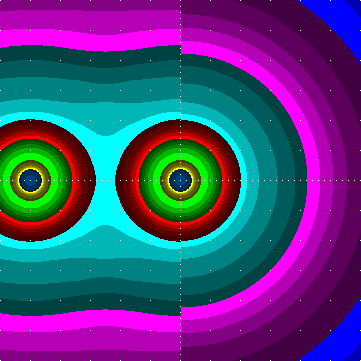


|

|
| In the left half of the left plot, specific illuminance by a continuous row of luminaires spaced 5 heights is shown (right half is for a single luminaire). | The right plot is for a single luminaire, unrotated. |

Values below the scale are illuminance / 1 lx. This is for (unrealistic) “unit” case that luminaires would have lamps producing 1 klm only, would be point-like and just 1 m over the terrain.
# IESNA:LM-63-1995
# [TEST] LRL 400-8U
# [MANUFAC] HYDREL LTG
# [LUMCAT] 4650 100S TSP
# [LUMINAIRE] Accent Light. Die-Cast Aluminum.
# [MORE] 3002-0 BRIGHT DIPPED SPECULAR CLEAR ANODIZED SPUN REFLECTOR - TSP
# [MORE] 8.5" DIA CLEAR FLAT LENS. TOTAL WATTS = 130
# [LAMP] CLEAR HIGH PRESSURE SODIUM T-10 PG-12 BASE.
# [LAMPCAT] 1 - 100W HPS WHITE SON
# [_LAMPLUM] 5200
# [_INFOLINK] www.lithonia.com/visual/ies/ies.asp?vfile=
# TILT=NONE
# Bulbs: 1, 5200 lm each
# Number of measured angles: 20 vertical, 1 horizontal ones
# Photometric type: 1, Units type: 1
# Luminous opening width, length and height: 0.000 0.000 0.000
# Ballast factor: 1, Input power: 130 W
# Source file: Hydrel\4650\4008Ua.ies
# Luminaire flux = 2319 lm,
# 44.6 % of the bulb flux
# between 75 and 90: 0.4 % of the luminaire flux
# - this part causes just GLARE in case of road lighting and similar purposes
# 80deg and above: max 1.3 cd/1000lm , 0.2 % of the luminaire flux
# 90deg and above: max 0.0 cd/1000lm , 0.0 % of the luminaire flux
# CutOff Type: Full_CutOff
# The following table gives luminous intensities which would be produced
# using a hypothetic bulb giving a luminous flux of 1000 lm (i.e., cd/klm):
0.0 794.2
5.0 907.7
15.0 755.8
25.0 124.0
35.0 50.8
45.0 50.4
55.0 13.7
60.0 5.6
62.5 4.2
65.0 2.9
67.5 2.9
70.0 2.7
72.5 3.1
75.0 3.3
77.5 2.3
80.0 1.3
82.5 1.2
85.0 0.8
87.5 0.4
90.0 0.0
(A similar table including even some other results can be computed at producer's website.)